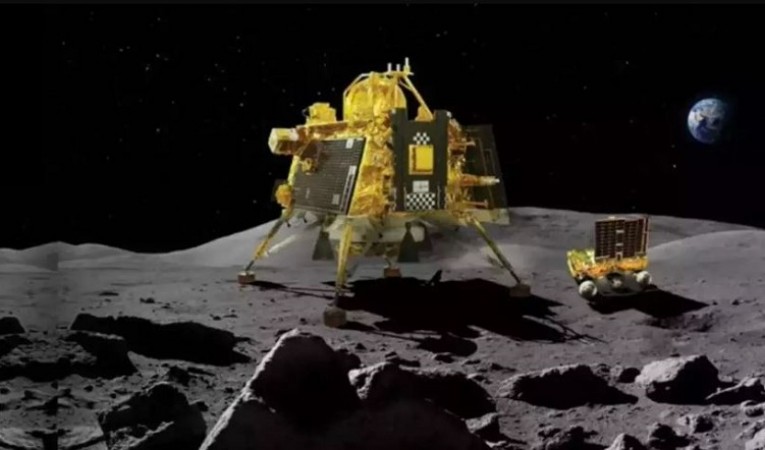
On August 23 at 5:40 p.m., the Chandrayaan-3 lander existed as a solid mass of metal, plastic, and glass, weighing 1.7 tonnes, whirling about 30 km above the lunar surface. However, within the next 23 minutes, an unprecedented event unfolded: it decelerated, stabilized itself, and with the guidance of an array of sensors and actuators, gently descended to the moon's terrain. By shortly after 6 p.m., a wave of jubilation spread across India as the lander made contact with the lunar surface. India proudly joins the ranks of only four nations that have achieved a successful soft landing on the moon, and notably, it claims the distinction of being the first to accomplish this feat in the moon's South Polar region. This achievement underscores the undeniable truth about complex space missions: their accomplishment is intertwined with the tenacity of human spirit due to their insatiable demand for resources and their tendency for unpredictability. These missions have the remarkable capacity to unite people, as evidenced by the enthusiasm generated by Chandrayaan-3 in India.
Also read
The immediate implication of the Chandrayaan-3 lander's presence on the moon is indicative of the Indian Space Research Organisation's (ISRO) astute learning from the setbacks of its predecessor, Chandrayaan-2. In 2019, during Chandrayaan-2's descent, contact was lost when the lander was a mere 2.1 km above the lunar surface. Through meticulous analysis of data transmitted until that point, along with inputs from various sources including the Chandrayaan-2 orbiter, ISRO discerned the root causes of the lander's premature failure. This led to modifications in 21 subsystems, culminating in the enhanced Chandrayaan-3 lander. This iteration boasts a remarkable feature: its redundancies, designed to seamlessly switch to alternate components or processes in case of failure.
Also read
From a broader temporal perspective, Chandrayaan-3 occupies a significant juncture. India has become a participant in the Artemis Accords, a U.S.-led collaborative endeavor aimed at landing humans on the moon by 2025, followed by an expansion of human exploration throughout the solar system. With its recent achievements, India has the potential to take a leading role among other Artemis countries, particularly those keen on leveraging the space sector to bolster their economies, alongside the United States. Although India and Russia were not engaged in a competitive race to reach the moon during this period, Russia's Luna-25 spacecraft failure on August 19 indicates limitations on its contributions to the International Lunar Research Station program in conjunction with China, which runs parallel to the Artemis Accords. With Chandrayaan-3, India has demonstrated proficiency across various interplanetary spacecraft types: orbiters, landers, and rovers. While the Chandrayaan-3 rover is basic, it underscores India's emphasis on planning and executing scientific missions. The insights gleaned from Chandrayaan-3's scientific instruments hold immense importance, as the mission aims to conduct the first-ever physical, chemical, and thermal characterization of the soil, subsoil, and atmosphere in the vicinity of the moon's South Pole. India now possesses a degree of technological advantage compared to most spacefaring nations, which should motivate further exploration within the solar system and advanced scientific endeavors.
Also read
The triumph of the landing also marks the conclusion of India's second phase of lunar exploration. The forthcoming third phase involves collaboration between ISRO and the Japan Aerospace Exploration Agency (JAXA) for the Lunar Polar Exploration (LUPEX) mission. This mission encompasses a lander and a rover dedicated to studying water-ice at the moon's South Pole. Notably, LUPEX will employ the same landing system developed by ISRO for Chandrayaan-2 and -3. This underscores the significance of Chandrayaan-2's surface component failure, which placed considerable pressure on its successor. It's worth noting that Russia was originally slated to provide this equipment for Chandrayaan-2, but circumstances following its unsuccessful Fobos-Grunt mission in 2011 compelled ISRO to develop its own.
Also read
Looking ahead, ISRO's trajectory is relatively fixed for future missions. Deviations, whether due to events like Chandrayaan-2, the COVID-19 pandemic, or sluggish rocket production, bear significant financial and political implications. Chandrayaan-3's success bolsters ISRO's confidence to transition to the next phase, encompassing endeavors like electrically powered satellites, quantum communications, human spaceflight, reusable launch vehicles, planetary habitation, and interplanetary communications. The evolving space industry necessitates enhanced launch frequency and reduced costs, where private sector contributions will play a pivotal role in accelerating innovation and opening new avenues for India's developmental progress. With this achievement, India stands exultant. From this point onward, ISRO holds the prospect of taking the lead.
Also Read